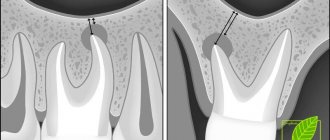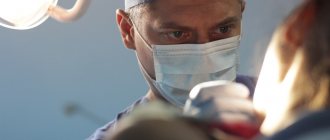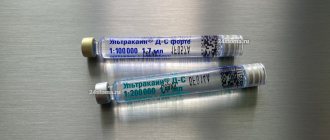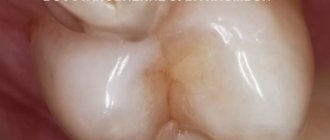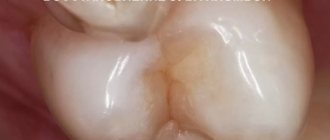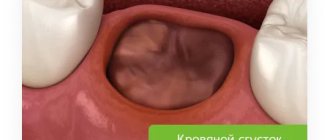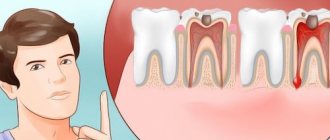We are publishing an article by Natalya Lvovna Mayorova, a dentist, therapist, and head of the therapeutic department of the Dentalika clinic.
Pain relievers used in modern dental practice can work wonders. After receiving an anesthetic injection, the patient does not feel any pain or even particularly unpleasant sensations. To ensure that the injection itself is painless, before the procedure the doctor “freezes” the injection site with a special preparation with a delicious smell of cherry, lemon, or apple.
Local anesthesia is the main method of pain relief used in dental practice. With local anesthesia, the patient remains fully conscious, and this allows the doctor to fully control the entire course of treatment, communicate with the patient, and monitor your reaction.
The quality of dental interventions depends on the results the doctor obtained during local anesthesia. Therefore, achieving 100% pain relief is necessary not only for the patient, but also for the doctor, in order to carry out treatment calmly, slowly, and efficiently. Hence the following requirements for local anesthetics:
- they must have a strong analgesic effect, easily penetrate into tissues and remain there for as long as possible;
- have low toxicity, causing a minimum number of both general and local complications
Based on these wishes, we chose several widely used drugs:
- Ultracaine DS forte (4% articaine, adrenaline 1:100,000);
- Ultracaine DS (4% articaine, adrenaline 1:200,000);
- Scandonest SVC (3% mepivacaine; without vasoconstrictors - adrenaline).
Now in more detail about their action.
Ultracain DS
The analgesic basis of the first two drugs is ARTICAINE (amide anesthetic from the thiophene series), an antispasmodic - lowers blood pressure. It is characterized by rapid action - anesthesia occurs in 0.5-3 minutes. Articaine is 2 times stronger than lidocaine and 6 times stronger than novocaine (anesthetics of previous generations), less toxic, relatively quickly eliminated from the body. Its half-life is, on average, 22 minutes, that is, all traces of the drug disintegrate in 44 minutes and are then completely eliminated from the body. Has high penetrating ability. It is distinguished by high purity of the solution. Allergic reactions to articaine are very rare - one in one hundred thousand injections ; the use of articaine, according to studies, is safe in 99.4% of cases. They also contain a vasoconstrictor (a substance that causes constriction of blood vessels and a decrease in blood flow in them) - adrenaline. The use of a vasoconstrictor continues and enhances anesthesia. The drug also contains antioxidants (sulfites) - substances that prevent the oxidation of adrenaline.
Ultracaine does NOT contain parabens (anesthetic preservatives), which significantly reduces its toxicity. In addition, parabens can cause allergic reactions.
Thus, ultracaine is:
- a strong anesthetic with moderately low toxicity, due to its components;
- the safest drug for pregnant women, because articaine does not penetrate the hematoplacental barrier - the barrier separating the blood of the fetus and the blood of the mother (Ultracaine DS).
School-age children can also use Ultracain DS. We always remember that the administration of an anesthetic solution with adrenaline is CONTRAINDICATED for children under 5 years of age, patients with pathologies of the cardiovascular system, with endocrine pathologies, taking antidepressants, thyroid hormones, drugs that block beta adrenergic receptors; - an anesthetic that practically does not require postoperative pain relief;
- a drug that provides a rapid onset of anesthesia, depending on the anesthesia tactics chosen by the doctor, the effect occurs within 30 seconds to 3-5 minutes);
The duration of anesthesia is, depending on the technique chosen by the doctor, from 1.5-2 hours to 5-6 hours. The choice of different techniques (infiltration, conduction anesthesia) depends on the planned dental procedure. For example, there is a difference between the treatment of caries of one tooth and the complex removal of a wisdom tooth. - good local and general tolerability. According to studies, only 4.3% of patients experienced toxic reactions, which was caused by the presence of adrenaline and sodium disulfate in the anesthetic solution.
- For standard procedures, a small amount of anesthetic is required (0.9 ml-1.8 ml).
I would like to note that for standard dental operations it is better to use Ultracain DS (adrenaline 1:200,000). A strong anesthetic provides high-quality anesthesia even during complex, long-term interventions, and a small amount of vasoconstrictor ensures low toxicity of the anesthetic solution. And we prefer to consider Ultracaine DS forte (adrenaline 1:100,000) as a “reserve anesthetic” in more complex situations:
- anesthesia of the lower lateral teeth (molars) for their treatment and depulpation;
- pain relief for inflammatory processes in the maxillofacial area (periostitis, osteomyelitis);
- for particularly traumatic interventions;
- in patients with a low pain threshold.
Compound similarities
For inflammatory diseases, injuries and other situations when it is necessary to relieve pain, anesthetics help solve the problem. Experts advise carefully choosing painkillers, focusing on the purpose of use and the individual characteristics of the body.
In case of exacerbation of diseases, during dental treatment and during simple surgical procedures, it is necessary to use painkillers Ultracaine or Lidocaine.
Ultracaine and Lidocaine are amide anesthetics. They are produced in the form of injection solutions. In the production of both anesthetics, the same excipient is used - water. These drugs have a similar effect on the body, reducing the speed of transmission of nerve impulses, causing tissue numbness.
Both drugs are used for local, regional and infiltration anesthesia.
This is where the similarities end. Despite the fact that the drugs have the same areas of application and solve the same problems, they are quite different. In some cases, it is impossible to replace one remedy with another.
Scandonest SVC
If the patient belongs to a risk group (with severe concomitant diseases , in particular cardiovascular pathology ), the use of an anesthetic solution with adrenaline, a vasoconstrictor, should be completely abandoned. In such cases we use Scandonest SVC . This anesthetic exhibits a vasoconstrictor effect, i.e. has vasoconstrictor properties and can therefore be used without adrenaline, which means that the drug does not contain sulfites and can also be used in patients with bronchial asthma and allergic conditions (after an allergy test). Scandonest SVC is a medium-strength anesthetic; provides anesthesia, depending on which part of the jaw the doctor disconnects from pain sensitivity, for 20 - 90 minutes, which sets it apart from the group of other non-adrenaline anesthetics.
Scope of application
The usual use of Ultracain is in dentistry for depulping teeth, removing them and other manipulations. The anesthetic penetrates well into bone structures and anesthetizes inflamed tissue. Due to this, Ultracain D-S is preferred when performing operations on ENT organs (removing tonsils, correcting a deviated nasal septum, etc.).
Lidocaine is used much more widely. In addition to pain relief, it is an antiarrhythmic drug that is used in cardiology. In addition, the drug is administered intravenously to relieve acute surgical and chronic pain; used in general anesthesia in combination with propofol. Lidocaine is convenient for superficial anesthesia during gastroscopy and other endoscopic examination methods. And, of course, it is still used as a local anesthetic in otolaryngology and dentistry.
Allergy tests
If you have previously experienced allergic reactions to medications, you have doubts, and you do not fully know which local anesthetics are safe for you, we strongly recommend that you undergo tests for allergic reactions at an allergy center before visiting the dentist. The addresses of such centers can be obtained from the reception of the Dentalika dental clinic. The test results can be completely trusted. This recommendation especially applies to parents of children who bring their children to the dentist for the first time. Unfortunately, from year to year the number of children susceptible to allergic reactions in our city is only growing. A visit to the allergy center will completely protect your child from possible complications.
Mechanism of action of amide series local anesthetics
The spread of a pain impulse in a nerve fiber occurs due to a change in the polarity of the cell membrane. The change in potential is ensured by the work of special membrane protein complexes, sodium and potassium channels. The former are responsible for the excitation and spread of the sensitive impulse, the latter – for restoring the original balance.
The local anesthetic molecule consists of fat-soluble and water-soluble fragments, which are linked by an amide bond. The lipophilic aromatic ring allows the anesthetic to penetrate deep into the cell membrane of the nerve fiber, and the hydrophilic group acts from the inside, blocking the activity of sodium channels. Sodium transport does not occur across the cell membrane, so the pain impulse is blocked.
Children
It should be noted separately the features of local anesthesia in children. The technique of local anesthesia in children must be planned so that 100% pain relief is achieved at all stages of treatment, otherwise it will be impossible to carry out the necessary manipulations.
As mentioned above, children under 5 years of age are given an anesthetic without adrenaline (3% scandonest SVC, or septanest 4% SVC).
Children over 5 years old can use an anesthetic with low concentration adrenaline (1:200,000 - Ultracaine DS). The dose of drugs is selected depending on age. Pain relief is performed in children in 3 stages:
- First, a superficial anesthetic gel is applied
- then a small dose (0.1-0.2 ml) of anesthetic is administered;
- after which, after 60-90 seconds (time sufficient for effective anesthesia of the needle path in the soft tissues), the remaining amount of the planned dose of anesthetic is administered.
We wait 5-10 minutes until complete anesthesia occurs. The child, feeling a complete absence of pain, gains confidence in the doctor and gives the opportunity to carry out the necessary intervention.
Conditions for dispensing from pharmacies
Lidocaine and Ultracaine are available from pharmacies with a doctor's prescription. Lidocaine spray is available without a prescription.
Price
Lidocaine is cheaper than Ultracaine, and the price difference is quite large. A pack of 10 Ultracain ampoules can be purchased at a pharmacy for 1100-1300 rubles. A similar package with Lidocaine ampoules costs 40-50 rubles. The average price of Lidocaine in the form of a spray is 200-250 rubles.
Several types of Ultracaine can be purchased in pharmacies. Varieties that are designed specifically for allergy sufferers are higher than classic Ultracaine.
Failed anesthesia
I would also like to touch upon the topic of unsuccessful local anesthesia. Almost every dentist has encountered this in their practice. The reasons for this phenomenon can be classified into 2 groups:
- depending on the doctor (poor choice of anesthesia technique and anesthetic solution; errors in the technique);
- depending on the anatomical and psychological characteristics of the patient.
To eliminate psychological causes in patients with a labile psyche (with increased emotionality, sensitivity, excitability), premedication is used: sedatives and sedatives.
In all other cases, the doctor must approach the choice of anesthetic and local anesthesia technique with even greater responsibility and professionalism, starting from the very first minutes of communication with the patient (history collection).
You should always remember that there are NO teeth that cannot be anesthetized, it’s just sometimes more difficult to achieve this.
High-quality pain relief minimizes patient discomfort and allows dentists to perform the necessary interventions.
Natalya Lvovna Mayorova doctor - therapist - dentist October 2009
Dear Colleagues! When copying information, placing a link to the source site is mandatory.
Reviews from doctors
Grigory, 33 years old, dentist, Nizhny Novgorod: “Over several years of medical practice, I have become convinced of the effectiveness of Ultracain, if all the individual characteristics of the patient and the problem that brought him to the dental office are taken into account. There were a couple of cases with side effects, but everything ended well.”
Tatyana A., 43 years old, neurologist, Minusinsk: “I use lidocaine at the request of patients, and when I doubt the choice of remedy, although such problems are rare.”

